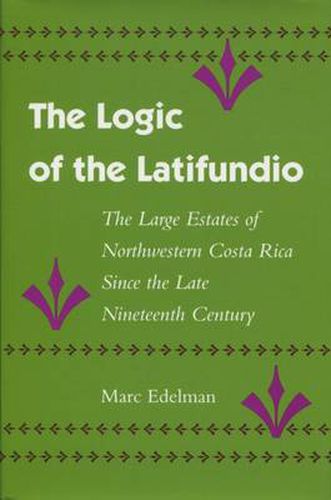Readings Newsletter
Become a Readings Member to make your shopping experience even easier.
Sign in or sign up for free!
You’re not far away from qualifying for FREE standard shipping within Australia
You’ve qualified for FREE standard shipping within Australia
The cart is loading…






This book has a deal purpose: to study the changing social relations in a region of Costa Rica that does not conform to the country’s accepted image as an ‘agrarian democracy,’ and to investigate why latifundios (large unproductive or underutilized estates) still dominate so much of the Latin American countryside. Many social scientists - anthropologists, historians, economists, and political scientists alike - have long suggested that latifundios would disappear (indeed, are disappearing) with the development of markets and capital-intensive agriculture. By contrast, this book demonstrates that latifundios continue to exist, and even to spread, in a dynamic modern export economy. The ‘logic’ of the persistence of latifundios is linked to world market forces, environmental constraints, state subsidies, and the influence of powerful landowners on development policies. The author argues that early twentieth-century latifundismo in Coasta Rica was based in large part on speculation and a subsidy from nature in the form of timber and feral cattle, and that it also reflected the difficulty of increasing investment in the context of a weak state and a locally powerful peasantry. During the 1930’s depression, landowners gained greater control over the rural poor. After 1950, a boom in beef exports fueled an expansion of latifundios that displaced thousands of peasants. In little more than a century, northwestern Costa Rica changed from a wooded, sparsely populated cattle frontier to a severely deforested region that produced sugar, cotton, and beef for export. The author traces the course of this history by examining the development of new technology and markets, peasant resistance to landlord expansion, state reforms, environmental destruction, and the politics of irrigation. He also explores the shifting composition of the local elite and the international cast of characters who acquired cast properties in northwest Costa Rica, including such varied figures as Nicaraguan dictators Luis and Anastasio Somoza, frontmen for Lyndon Johnson, Oliver North’s Iran-Contra agents, and Jimmy Swaggart.<
$9.00 standard shipping within Australia
FREE standard shipping within Australia for orders over $100.00
Express & International shipping calculated at checkout
This book has a deal purpose: to study the changing social relations in a region of Costa Rica that does not conform to the country’s accepted image as an ‘agrarian democracy,’ and to investigate why latifundios (large unproductive or underutilized estates) still dominate so much of the Latin American countryside. Many social scientists - anthropologists, historians, economists, and political scientists alike - have long suggested that latifundios would disappear (indeed, are disappearing) with the development of markets and capital-intensive agriculture. By contrast, this book demonstrates that latifundios continue to exist, and even to spread, in a dynamic modern export economy. The ‘logic’ of the persistence of latifundios is linked to world market forces, environmental constraints, state subsidies, and the influence of powerful landowners on development policies. The author argues that early twentieth-century latifundismo in Coasta Rica was based in large part on speculation and a subsidy from nature in the form of timber and feral cattle, and that it also reflected the difficulty of increasing investment in the context of a weak state and a locally powerful peasantry. During the 1930’s depression, landowners gained greater control over the rural poor. After 1950, a boom in beef exports fueled an expansion of latifundios that displaced thousands of peasants. In little more than a century, northwestern Costa Rica changed from a wooded, sparsely populated cattle frontier to a severely deforested region that produced sugar, cotton, and beef for export. The author traces the course of this history by examining the development of new technology and markets, peasant resistance to landlord expansion, state reforms, environmental destruction, and the politics of irrigation. He also explores the shifting composition of the local elite and the international cast of characters who acquired cast properties in northwest Costa Rica, including such varied figures as Nicaraguan dictators Luis and Anastasio Somoza, frontmen for Lyndon Johnson, Oliver North’s Iran-Contra agents, and Jimmy Swaggart.<